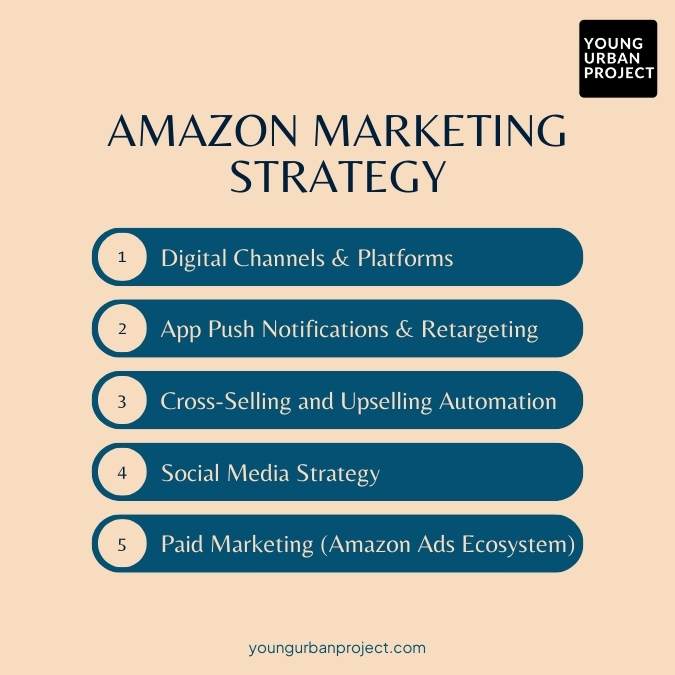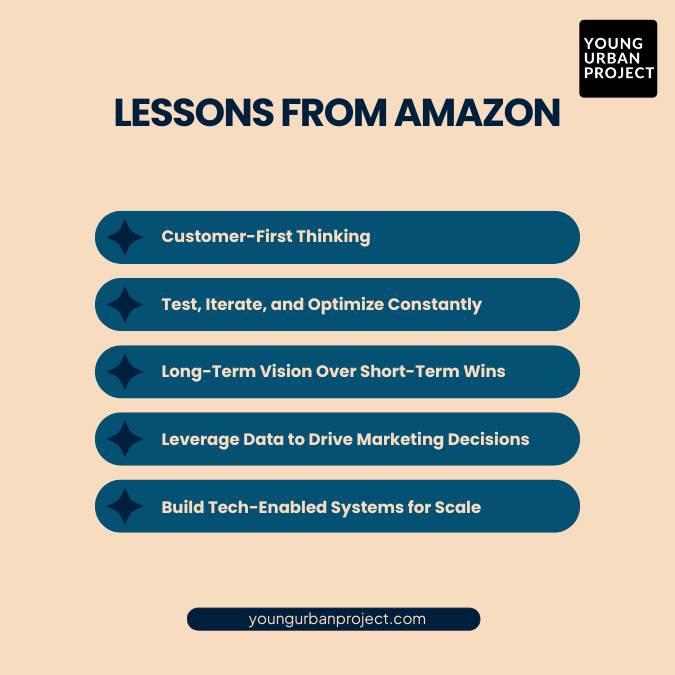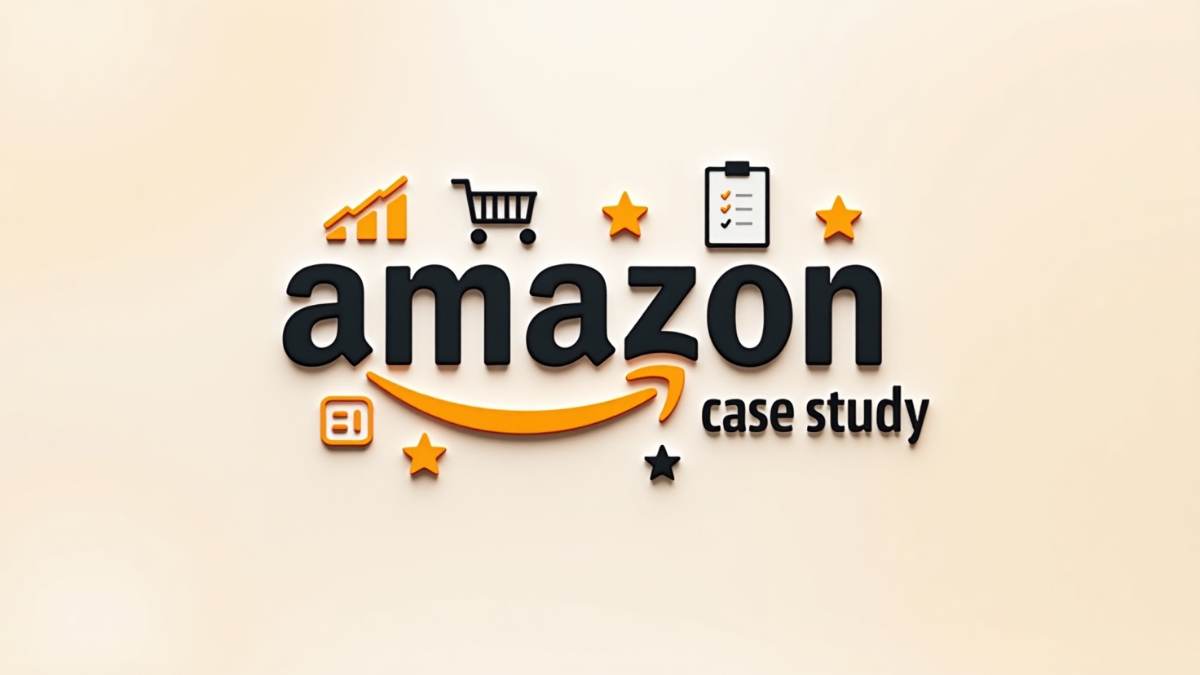You’ve probably ordered from Amazon more times than you can count. But it’s wild to think it all started as a simple online bookstore run out of Jeff Bezos’ garage back in 1994. No warehouses, no Prime, no Alexa- just books and a bold idea.
Table of Contents
Fast forward to today, and Amazon isn’t just a store. It’s a tech powerhouse, a logistics machine, and one of the most customer-obsessed brands on the planet.
In this Amazon Case Study blog, we’ll break down how Amazon built this empire, from its unique business model to its insanely effective marketing strategy. Whether you’re building a startup or growing a brand, there’s a lot to learn from how Amazon plays the game (and wins it).
Amazon’s Core Business Model Explained
1. E-commerce, Cloud (AWS), Subscription (Prime), Logistics
Amazon isn’t just an online store. Its revenue comes from multiple streams: product sales, cloud computing (AWS), paid subscriptions like Prime, and its own logistics network. This diverse model spreads risk and maximizes growth potential across industries.
2. How Amazon Diversified into Multiple Verticals
From selling books to launching Kindle, Alexa, Amazon Go, and even entering healthcare—Amazon has a history of entering new verticals where customer experience can be improved. The key? Identify friction points in existing industries and solve them better than anyone else.
3. What Makes Amazon’s Business Model Unique
It’s the ecosystem. Amazon builds systems that feed into each other. Customers buy on Amazon, sellers sell on it, AWS powers the back-end, and Prime locks users in with perks. Each part supports the other, creating a cycle of retention and revenue.
4. Continuous Innovation as a Core Pillar
Amazon’s culture pushes for constant experimentation. Teams are encouraged to test ideas—even if they fail. This “Day 1” mindset keeps the company agile and ahead of trends, whether it’s in AI, logistics, or user experience.
Amazon’s Brand Strategy: 4 Key Pillars
1. Customer Obsession – Customer-Centric Philosophy
Everything at Amazon starts with the customer. The company reverse-engineers from customer needs rather than focusing on what competitors are doing. This obsession shapes product features, delivery speed, and even pricing decisions.
2. Convenience & Trust – Fast Delivery, Easy Returns
Amazon redefined convenience. One-click ordering, next-day delivery, and no-questions-asked returns make shopping frictionless. This ease builds long-term trust, turning casual buyers into loyal customers.
3. Personalization & AI – Smart Recommendations, AI Reviews
Amazon uses machine learning to personalize your experience. From “Recommended for You” to review summaries powered by AI, it creates a shopping experience that feels tailored—making customers more likely to buy (and return).
4. Global Scale with Local Focus – Region-Specific Strategies, Community Impact
Amazon adjusts its strategy by geography. In India, it offers cash-on-delivery; in Japan, it emphasizes local partnerships. This ability to scale globally while customizing locally helps Amazon win trust and relevance across cultures.
Amazon Marketing Strategy: A Deep Dive

1. Digital Channels & Platforms
Amazon’s digital marketing machine runs 24/7. It leans on SEO to capture intent-based traffic, uses email to drive repeat purchases, and runs a huge affiliate program. Influencers and bloggers help push products subtly. Plus, push notifications and smart retargeting bring shoppers back when they bounce.
2. App Push Notifications & Retargeting
Ever left something in your Amazon cart and got a gentle nudge later? That’s retargeting in action. Amazon combines app notifications with web tracking to re-engage users. It’s subtle but super effective—catching people when they’re most likely to buy.
3. Cross-Selling and Upselling Automation
When you see “frequently bought together” or “customers also viewed,” that’s no coincidence. Amazon uses data to suggest related products and bundle deals. It doesn’t just increase order value—it feels helpful, not salesy. That’s the genius of their upsell strategy.
4. Social Media Strategy
Amazon doesn’t flood your feed—they play it smart. You’ll see product how-tos, influencer collabs, meme-style content, and major seasonal pushes. Platforms like Instagram and Pinterest are used visually, while Twitter handles support. Everything’s on-brand but tailored to each platform’s vibe.
5. Paid Marketing (Amazon Ads Ecosystem)
Amazon doesn’t just advertise on other platforms—it sells ads inside its own ecosystem. Sponsored Products pop up in searches. Headline Search Ads promote categories. Display Ads show up on product pages. The ads feel native, not intrusive—and that’s what makes them perform.

Enroll Now: Live Advanced Digital Marketing Course
The 4Ps of Amazon’s Marketing Mix
1. Product: Vast Catalog, Amazon Go, Amazon Fresh
From books to groceries to smart fridges—Amazon’s product range is insane. But it’s not just volume. Stores like Amazon Go or services like Fresh show how they keep evolving the product experience, blending offline with tech in very cool ways.
2. Price: Dynamic Pricing, Value-Driven Offers
Amazon prices change constantly. It’s not random—it’s algorithmic. They adjust based on demand, competition, and inventory. Plus, they run frequent deals and Prime exclusives that keep price-sensitive shoppers locked in without hurting perceived value.
3. Place: Global Presence, Warehousing, Amazon Logistics
Amazon’s “place” is basically everywhere. Their massive warehouse network and delivery hubs give them reach that few can match. They’ve even built their own planes and delivery vans. Owning their distribution means faster delivery and lower reliance on third parties.
4. Promotion: Prime, Prime Day, Lightning Deals
Amazon promotes like a pro. Prime offers perks that feel too good to pass up. Prime Day? It’s basically their own holiday. They also use Lightning Deals and flash sales to trigger urgency. The promo strategy keeps the FOMO real.
Also Read: What Is Marketing Mix? The 4 Ps of Marketing
Logistics & Supply Chain Mastery
Amazon’s logistics game is next level. They’ve built a system where products move from warehouse to doorstep at jaw-dropping speed. Same-day or next-day shipping isn’t magic—it’s smart tech, tight operations, and a ridiculous amount of planning behind the scenes.
1. Real-Time Inventory & Last-Mile Delivery
Every product you see online is tracked in real time. That’s how they promise accurate delivery windows. The “last mile”—from local hub to your door—is optimized with Amazon Flex drivers and predictive routing. It’s logistics science in motion.
2. Role of Technology and Automation in Supply Chain
Warehouses aren’t full of humans picking boxes anymore. Amazon uses robots, conveyor systems, and machine learning to make their supply chain fast and precise. It’s not just faster—it reduces errors, saves costs, and scales like crazy.
Technology, AI & Amazon Web Services (AWS)
1. Use of Machine Learning for Personalization
Ever feel like Amazon reads your mind? It kinda does. Their machine learning systems analyze your behavior and predict what you might want next. From homepage suggestions to tailored emails, personalization keeps the experience sticky.
2. AI-Powered Product Reviews & Purchase Predictions
Amazon now uses AI to summarize reviews—so instead of reading 500 opinions, you get a quick highlight. It also predicts what you might reorder before you even think about it. That’s AI doing the work behind the scenes.
3. AWS’s Role in Amazon’s Scalability and Profit Margin
While everyone talks about retail, AWS is the real cash cow. Amazon Web Services powers not just Amazon’s tech—but also Netflix, Airbnb, and tons of other companies. It’s massively profitable and lets Amazon invest back into growth.
4. Innovations like Cashier-less Amazon Go Stores
Walk into a store, grab stuff, and just… leave. That’s Amazon Go. No lines, no checkout. Sensors, cameras, and AI track what you take. It’s not just cool—it’s a glimpse into retail’s future, and Amazon’s way of redefining shopping again.
Also Read: Netflix Case Study
Understanding Amazon’s Customers
Who Buys on Amazon (Demographics & Behaviors)
Amazon serves everyone—from college students to busy parents to senior citizens. Most customers are looking for convenience, fast delivery, and fair prices. Behaviors vary, but impulse buys, bulk orders, and repeat shopping are common. Reviews play a big role in decisions, and mobile usage is super high.
Why Customers Stay Loyal (Prime, Service, Experience)
Prime keeps people locked in, no doubt. Free shipping, exclusive deals, and streaming content add serious value. But it’s not just perks—the customer service is reliable, returns are painless, and the entire shopping experience just… works. That ease creates loyalty without even trying too hard.
Partnership & Collaboration Strategy
Amazon x Third-Party Sellers
Over half the stuff sold on Amazon isn’t by Amazon—it’s third-party sellers. Anyone can set up shop and access millions of buyers. Amazon provides the platform, tools, and sometimes even handles shipping. It’s a win-win and helps the platform grow without stocking everything themselves.
Logistics Partners & Tech Alliances
To keep things moving, Amazon works with thousands of delivery partners and couriers worldwide. On the tech side, they team up with AI firms, data companies, and even device makers. These partnerships let Amazon innovate faster and reach places it couldn’t do alone.
Ecosystem That Scales Without Heavy Inventory
Amazon’s secret sauce? It doesn’t own everything it sells. With Fulfilled by Amazon (FBA), third-party sellers ship their products to Amazon’s warehouses, and the company handles the rest. This setup allows massive scale—without drowning in inventory or supply chain headaches.
Also Read: Starbucks Case Study: Marketing Strategy & Growth
Business Growth & Market Expansion
Entry into New Industries: Entertainment, Healthcare, Grocery
Amazon isn’t just selling products—it’s entering entire industries. Think Prime Video for entertainment, Amazon Pharmacy for healthcare, and Whole Foods for groceries. It looks for areas with friction, then offers a smoother solution. Every move brings in new customers and revenue streams.
Global Expansion Playbook
Amazon doesn’t just copy-paste its U.S. model abroad. It localizes—offering cash-on-delivery in India or partnering with local brands in Japan. Each market gets a tailored approach. But the backbone (tech, logistics, Prime) stays consistent. That mix of local relevance + global power is hard to beat.
How Amazon Became a Platform, Not Just a Retailer
At some point, Amazon stopped being just a store—it became the platform. Sellers, advertisers, developers, and publishers—all use Amazon’s infrastructure to grow their businesses. AWS fuels apps and websites. Prime builds loyalty. Marketplace expands inventory. It’s an engine other companies now run on.
Also Read: Amul Case Study
Challenges Amazon Faced & How It Solved Them
Regulatory Scrutiny
Governments worldwide have raised concerns about Amazon’s data use, privacy practices, and dominance. In response, Amazon has started complying more actively, lobbying more strategically, and being more transparent (at least on the surface). It’s learning how to navigate the politics of being too big.
Labor and Warehouse Issues
Working conditions in Amazon’s warehouses have faced major heat, long hours, high targets, safety complaints. Amazon’s response? Raise wages, add automation, and launch PR campaigns. Some issues persist, but the company tries to balance speed with human needs—though critics argue there’s still a long way to go.
Antitrust & Monopoly Accusations
Critics say Amazon squeezes out smaller sellers, undercuts competition, and controls too much market share. Regulators have opened investigations. Amazon usually responds with data showing how it helps small businesses and promotes competition. It’s an ongoing legal battle—and one they’re constantly preparing for.
Also Read: AirBnb Customer Acquistion Case Study
Lessons for Startups, Brands & Marketers

1. Customer-First Thinking
Amazon doesn’t start with what’s profitable. It starts with what customers need. That mindset helps them build loyalty and trust. For any brand, putting the customer experience at the center is a long-term win—even if it costs a little more upfront.
2. Test, Iterate, and Optimize Constantly
Amazon experiments all the time. From tiny design tweaks to major feature rollouts, nothing is set in stone. If something doesn’t work, they fix it fast. The key takeaway? Don’t wait for perfect. Launch, learn, improve.
3. Long-Term Vision Over Short-Term Wins
Jeff Bezos famously said, “We’re willing to be misunderstood for long periods of time.” Amazon plays the long game. Instead of chasing fast profits, they invest in ideas that might take years to pay off. Most brands don’t think this way—but should.
4. Leverage Data to Drive Marketing Decisions
Every click, scroll, and search on Amazon is tracked and analyzed. That data feeds into pricing, inventory, ads, and personalization. Small brands might not have big data teams—but you can use basic analytics to shape smarter marketing moves.
5. Build Tech-Enabled Systems for Scale
Amazon doesn’t rely on manual work. It builds systems that scale—automation, AI, cloud services. Even small startups can adopt tools that help them grow without burning out their teams. Tech is no longer optional—it’s your growth partner.
Also Read: McDonald’s Case Study
Key Takeaways
Amazon’s success isn’t just about size. It’s about obsession with customers, smart use of tech, and the guts to keep evolving.
Their approach isn’t only for billion-dollar companies—startups and small brands can apply the same principles on a smaller scale.
When you blend data, logistics, and marketing with long-term thinking, you build something pretty hard to compete with.
Conclusion: Applying the Amazon Way
Amazon’s story proves that consistent customer obsession, backed by tech and bold decisions, creates unstoppable momentum.
Whether you’re a startup founder or digital marketer, you don’t need a trillion-dollar budget to apply these ideas. Start small: focus on your audience, use tools to scale smarter, and don’t be afraid to test new paths.
Want to dive deeper into how performance marketing powers brands like Amazon? Check out Young Urban Project’s workshops and courses—built for modern marketers like you.
FAQs: Amazon Case Study
1. What is Amazon’s core business model?
Amazon combines e-commerce, subscriptions (like Prime), cloud services (AWS), and logistics. It’s not one business—it’s an ecosystem.
2. How did Amazon grow from an online bookstore to a tech giant?
By constantly innovating, expanding into new industries, and always putting the customer first. They never stayed comfortable.
3. What are Amazon’s key marketing strategies?
Data-driven marketing, personalization, powerful ad placements, and building loyalty through Prime. They mix organic and paid with precision.
4. How does Amazon use AI and machine learning in marketing?
AI powers product recommendations, pricing decisions, review summaries, and ad targeting. It helps create a tailored experience for each user.
5. What is Amazon Web Services (AWS) and why is it important?
AWS is Amazon’s cloud business. It hosts websites, apps, and data for other companies—and it’s one of Amazon’s biggest profit drivers.
6. What can small businesses learn from Amazon’s success?
Think long-term, build for the customer, use data smartly, and don’t be afraid to enter new spaces if you can improve the experience.

